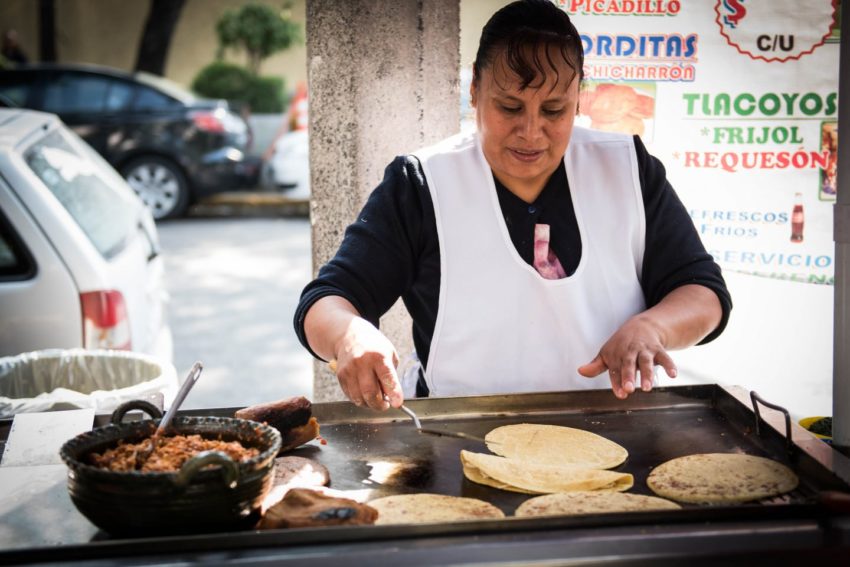Eight must-try Mexico City foods made with corn masa

In Mexico, corn was the beginning. In Mexico, we are made of corn.
About 9,000 years ago in southern Mexico (some historians say in the Tehuacán Valley, others point to the Balsas River Valley), the process of domestication of the most important grain of the Americas started with a little grass called teocintle. For the Maya, this grass, and its eventual resulting corn dough, or masa, was the sacred material that divinities used to create the first persons in the world. Maize is without hesitation the most important crop in Mexico, linked to Mexican history, traditions, and identity.
Thanks to the knowledge of Mexican farmers, and seed exchange, Mexico is still home to 59 unique corn landraces that have been adapted to diverse environmental conditions, each one unique and necessary in cooking different delicacies made with masa. To properly make this masa, Mexicans use an ancient process: nixtamalization, the most important culinary technique in Mexican cuisine.
To nixtamalize corn, dried corn is boiled in water with an alkaline solution (usually ash or slaked lime) until the corn kernels have reached the desired doneness, usually anywhere from 30 minutes to one hour, depending on the type of corn and how much is used. Then the corn is removed from the heat to soak overnight, and finally it is washed and ground. Nixtamalizing corn unlocks its hidden nutrients and gives the masa greater nutritional value, with more bioavailable vitamins, fiber, amino acids, and fewer mycotoxins.
At Eat Mexico, we want you to eat like a Mexican and try some of the different delicacies made with nixtamalized corn masa. These are some of the items you will find in our tours.
Tortilla

The staple item for the Mexican diet, the tortilla is the base for tacos, and it can be used as an edible plate or spoon. Different types of corn are used to prepare this circular disc made of nixtamalized masa, and the size and technique varies regionally. In Central Mexico, the tortilla press is popular; in Michoacán, you see women making tortillas using only their hands. In the Yucatán Peninsula they press the masa against a surface with the hand.
Tamal

From the Nahuatl word tamalli, which means wrapped, this dish mixes pre-hispanic techniques with ingredients brought by the Spaniards after the Conquest. In Mexico City, tamales are made with nixtamalized corn, pork lard, and different stuffings: mole, salsa verde, or rajas, or are simply sweetened with sugar and painted with pink food dye. They are usually only available for breakfast or dinner.
Tlacoyo

Another dish with prehispanic roots, tlacoyos are oval-shaped masa patties, stuffed with refried beans, fava beans, or requesón, a soft, creamy cheese. Cooked on a comal without any oil, they are topped with cactus or quelites (native Mexican greens), fresh cheese, onion, cilantro and salsa upon serving. This item is popular for breakfast and lunch.
Gordita
Similar to tlacoyos but with a circular shape, gorditas (which translates to “little fatties”) are most popularly stuffed with meaty bits of chicharrón. However, you can also find them stuffed with requesón, carnitas or potatoes. This antojito could be cooked on a comal without any oil, or, my favorite, deep-fried.
Quesadilla

Made with a folded tortilla, this antojito does not necessarily have cheese in Mexico City. (But that’s only the case in Mexico City!) Cooked vegetables like squash blossoms or mushrooms, or stewed chicken and beef, are the most popular fillings. Quesadillas can be cooked on a comal with no fat, but there is also a deep-fried version in which the masa is often combined with wheat flour for more crunchiness.
Enchilada
A folded tortilla swamped in different salsas, such as salsa verde, pipián or mole, and topped with fresh crumbled cheese and onion. The enchilada can be stuffed with shredded, poached chicken, crumbled cheese or vegetables, but the most important thing, apart from a good quality tortilla, is a good and well-seasoned salsa. As we say in Mexico: it must have sazón.
Tostada

This is a cold dish prepared with a deep-fried, crunchy tortilla. In healthier versions, the tostada is cooked in an oven without oil, which gives it a similar crunchy texture. The toppings are similar to the quesadilla fillings, but also you can find pickled cow’s feet and shredded, stewed beef with tomato, cilantro, onion. Seafood versions usually contain octopus, shrimp or ceviche.
Atole

This is a sweet beverage made with water or milk, in which the masa is dissolved and boiled until thickened. In pre-hispanic times, the beverage was traditionally savory, but that changed when the Spaniards brought sugar. In some places in Mexico it’s served like a soup, seasoned with herbs, chiles, and sometimes meat or vegetables. Some fermented versions are also found in southern Mexico.
Alejandro Dungla is a freelance food writer in Mexico City and an Eat Mexico culinary guide.